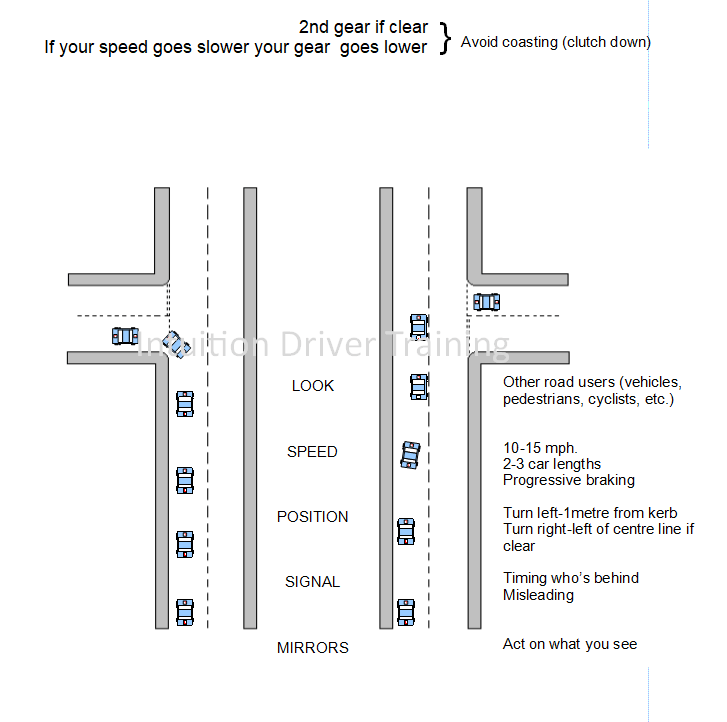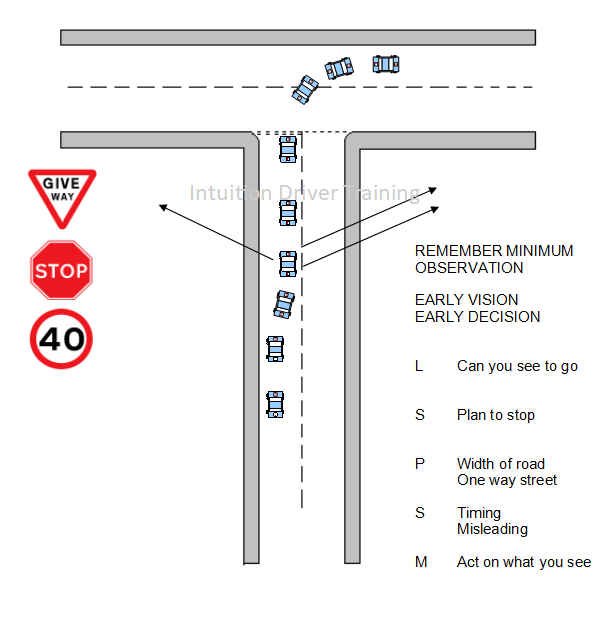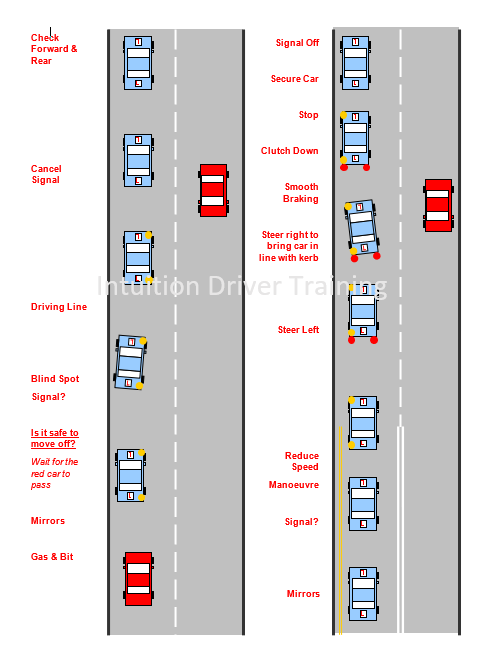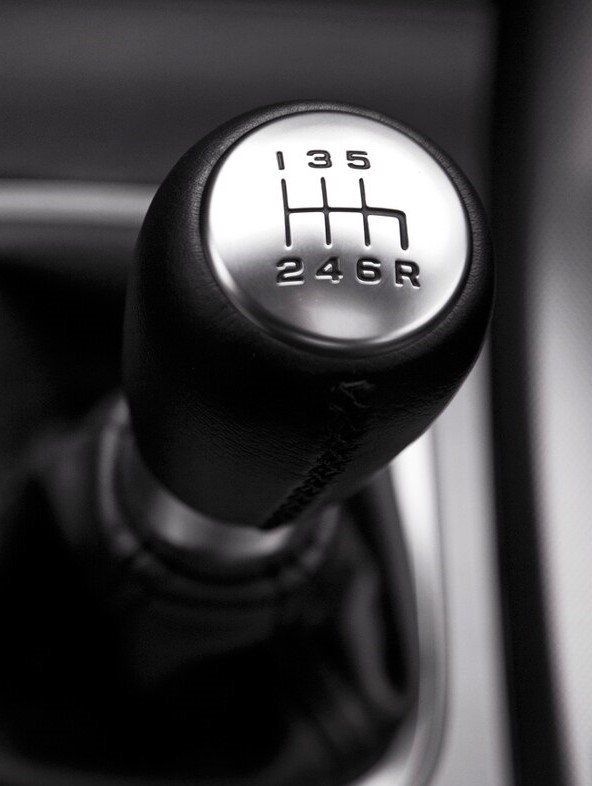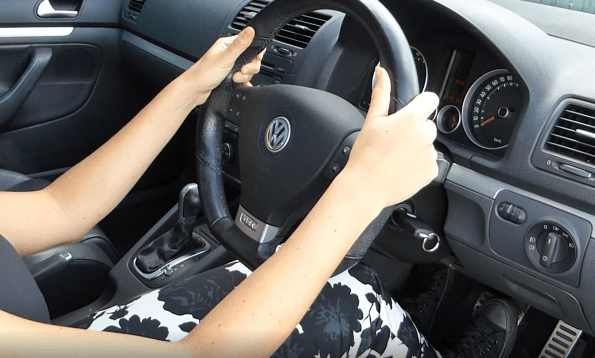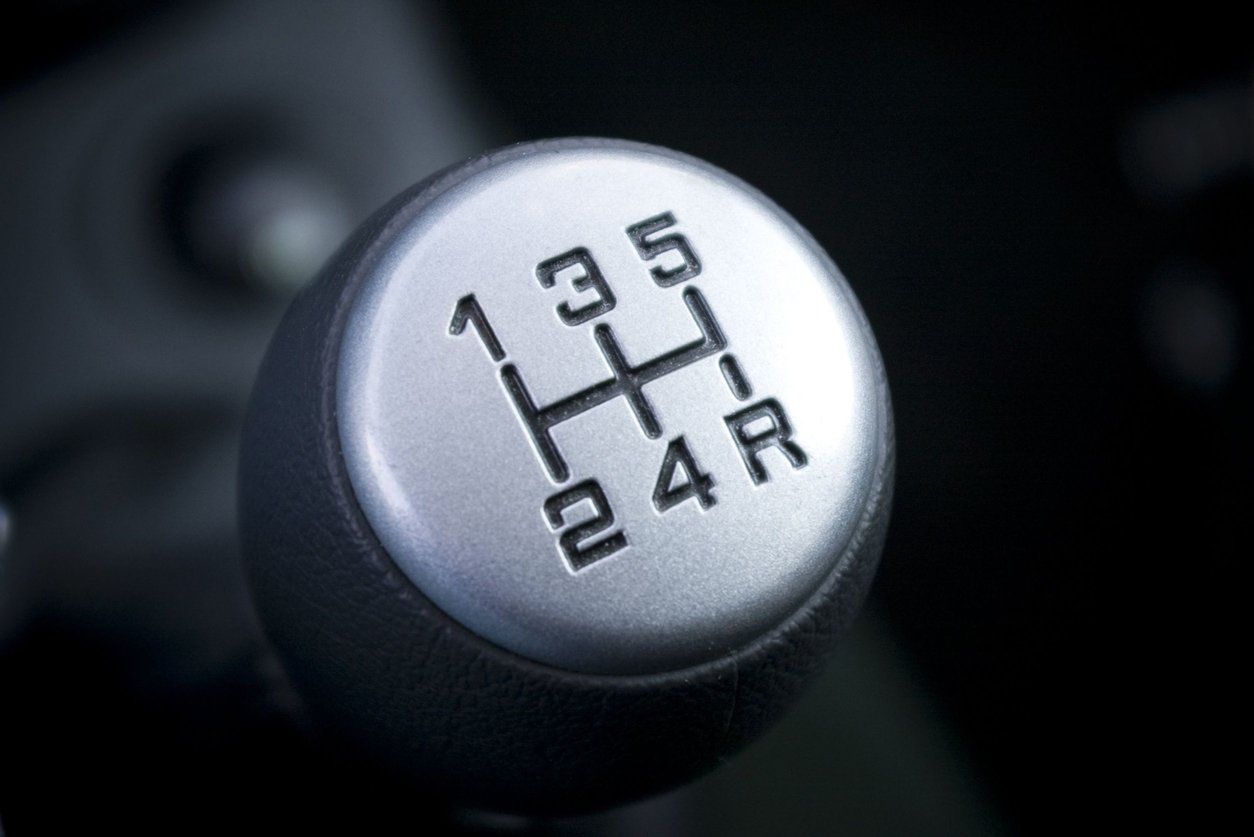Virtual Driving Lesson 4 - Turning left and right
Dave Humphries • April 20, 2020
Lesson Four-Turning left and right

In this week’s lesson we are going to look at turning left and right from a major road into a minor road, or in everyday language, from a main road into a side road. We have come across MSM in our moving off lesson we are going break down the manoeuvre part t help to put it into smaller steps. So, this will become MSPSL, which will be explained below. The MSPSL routine or hazard drill will become an important part of your driving. Basically, every hazard you approach, be it any junctions, parked cars, pedestrian crossing, and any other hazards you approach. You will need to use the MSPSL routine.
If driving an Automatic car, you will approach using the same method, MSPSL. Follow the routine below and note the differences in the Look sections.
Turning Left-MSPSL Routine
Mirrors:
Start by checking your interior and left mirrors. You need to check these early so you can act on what you see and assess on how your actions will affect other road users.
Signal:
Let other road users know your intentions by giving a left signal in plenty of time. Look out for other side roads on the left or any hazards for example a parked car and avoid giving a misleading signal. Remember. think how your signals will be interpreted by others.
Position:
In most cases it will not be necessary to change position on approach to a left turn as you will already following your driving line (approx. 1m from kerb). Try and keep a position of 1m around the corner.
Speed:
Bring down your speed smoothly and gradually, avoid harsh late braking. You will try and get your speed down to about 10 to 15 mph at about 2 to 3 car lengths from the junction.
Look:
What you see then depends on what you will do with your speed. If its clear you will generally choose 2nd gear. It is then important to bring your clutch up (this avoids coasting) and gives you full control of your car. Keep your foot off the gas, this is referred to as walking your car. Remember to check your left door mirror for cyclists before you turn.
If it’s not clear or it’s a tight narrow junction you can reduce your speed and choose 1st gear (5mph or lower). This will give you more time and control.
Be especially careful of pedestrians who may step out onto the road. Remember pedestrians already on the road have priority.
Once you have made the turn don’t accelerate until you have straightened up and check your mirrors before you accelerate.
In an automatic
car the same speed will apply, 10-15 mph at about 2 to 3 car lengths. Keep your foot off the gas, this will give you the same effect as walking the car (known as creep). If it's not clear or a tight junction, slow your car down with the brake to 5mph or lower. This will give you more time and control.
Turning Right-MSPSL Routine
Mirrors:
Start by checking your interior and right mirrors. You need to check these early so you can act on what you see and assess on how your actions will affect other road users.
Signal:
Let other road users know your intentions by giving a right signal in plenty of time. Look out for other side roads on the right or any hazards for example a parked car (even on the right). This could affect your position with on coming traffic. and avoid giving a misleading signal. Remember. think how your signals will be interpreted by others.
Position:
In most cases it necessary to change position on approach just to the left of the centre line (if safe to do so). If there is no centre line or the road is narrow, then keep your normal position. You will need to look for your point of turn to avoid cutting corners. To do this, line the front of your car with the centre line in the side road you are turning into to.
Speed:
Bring down your speed smoothly and gradually, avoid harsh late braking. You will try and get your speed down to about 10 to 15 mph at about 2 to 3 car lengths from the junction.
Look:
What you see then depends on what you will do with your speed. If it’s clear you will generally choose 2nd gear. It is then important to bring your clutch up (this avoids coasting) and gives you full control of your car. Keep your foot off the gas, this is referred to as walking your car. Remember to check your right door mirror just in case someone is overtaking. Also, with turning right you are crossing the path of other vehicles. So, look out for oncoming vehicles. You should not turn if this will cause oncoming vehicles to change speed or direction. Do not turn into the new road if the side road is clear, for example if their is queuing traffic, or pedestrians in the side road and this will cause you to stop and block oncoming traffic.
If it’s not clear or it’s a tight narrow junction you can reduce your speed and choose 1st gear (5mph or lower). This will give you more time and control. Be especially careful of pedestrians who may step out onto the road. Remember pedestrians already on the road have priority.
Once you have made the turn don’t accelerate until you have straightened up and check your mirrors before you accelerate.
In an automatic
car the same speed will apply, 10-15 mph at about 2 to 3 car lengths. Keep your foot off the gas, this will give you the same effect as walking the car (known as creep).
If it's not clear or a tight junction, slow your car down with the brake to 5mph or lower. This will give you more time and control.

As your practical driver training has had to stop temporarily due to Covid-19, to help you to continue your learning at home, have a go at our driving knowledge quiz either to work through on your own, or as a household, to see who has the best knowledge about driving! Each question can have more than one correct answer and it is down to you to get all of the answers correct. Have fun and check in tomorrow for the answers Private Practice Q1.You would like to go out training in your own car. What do you need on the vehicle to be legal as a learner? A. P plates front and back B. A roof box, displaying a green L plate to the front and back C. A dent on the car D. Red L-plates to the front and back Q2. When can you apply for a provisional licence? A. At 15 years and 6 months if you are on the enhanced rate of the Personal Independence Payment (PIP) B. At 16 if you are not on the enhanced rate of the Personal Independence Payment (PIP) C. 15 D. 17 Q3. What is meant by ‘accompanying driver’? A. This is a back seat passenger aged 18 or over who can already drive B. This is someone aged 21 who can follow in the car behind C. This is someone aged 21 who, although banned, knows how to drive D. This is someone aged 21 who has had a driving licence for three or more years Q4. Where must the ‘accompanying driver be’? A. In the front passenger seat B. In the rear seat behind the driver C. In a following car D. None of these Q5.Who is in charge of the vehicle? A. The owner of the vehicle B. The registered keeper C. You D. The accompanying driver Night driving Q1. When does the Highway Code say you need to put on your headlights? A. Ensure all sidelights and rear registration plate lights are lit between sunset and sunrise B. Ensure all sidelights and rear registration plate lights are lit between sunrise and sunset C. Use fog lights at night Q2. When stationary in a queue of traffic at night, you should: A. Apply the handbrake and take your foot off the footbrake to reduce dazzle B. Keep your foot on the footbrake at all times C. Not apply the handbrake Q3.What are defined as the hours of darkness in the Highway Code? A. The period between half an hour after sunset and half an hour before sunrise B. The period between half an hour before sunset and half an hour after sunrise C. When it is cloudy Q4. You must use headlights in the daytime when: A. Visibility is seriously reduced (100m or less) B. Visibility is less than 50m C. All the time Q5.The dashboard light to show your ‘main’ or ‘full’ beam headlights are on is usually: A. Blue B. Amber C. Red Rural driving Q1.Some additional hazards you may encounter on a rural road could be: A. Narrow and unlit roads B. Hidden junctions C. Farm animal and vehicle Q2. What are some of the clues you could look for to see if there is any oncoming traffic as you approach a bend or junction? A. Look across or through hedgerows B. Listen for approaching vehicles and/or sound of a horn from an approaching vehicle C. Look for headlights Q3. You see mud on the road by the entrance to a field. What do you need to look for? A. Tractor or farm vehicles B. Animals C. The farmer Q4. How might you know that horse riders may be ahead? A. Fresh horse manure on the road B. Road signs to warn of horse riders ahead C. A national speed limit applies Q5. What are passing places? A. Wider areas of the road to help vehicles pass each other B. When the road is narrow they help traffic to pass each other more easily C. A passing place is a rural version of a T-junction Vulnerable road users Q1. Who are considered vulnerable road users? A. Pedestrians B. Cyclists C. Motorbikes Q2. What makes cyclists vulnerable? A. They are not seen as easily B. They are small and can be hidden behind other vehicles and obstructions C. Drivers tend to look for cars and larger vehicles first Q3. You see a pedestrian with a white stick and red bands around the stick. What does this mean? A. They are visually and hearing impaired B. They are only visually impaired C. They are only hearing impaired Q4. You see horse riders ahead, what should you do? A. Slow down and give them plenty of space B. Don’t rev your engine or sound your horn C. Watch the horse rider for any signals they may give to you Q5. Why are the elderly considered to be vulnerable? A. Their eyesight and/or hearing may not be as good as it was B. Their ability to judge the speed and distance of oncoming traffic may be impaired C. They are able to move very quickly General knowledge Q1. What is a ‘zig-zag’? A. The white lines painted in the road preceding a pedestrian controlled crossing B. The black and white posts with red or white reflectors found on the side of the road C. The lights found at a level crossing, fire station and ambulance station, bordered by red and white squares Q2. A road bordered with street lights with no speed limit signs tends to have what speed limit? A. 20 mph B. 30 mph C. 40 mph Q3. What is the definition of a dual carriageway? A. A road with two lanes, one in each direction, separated by a solid white line B. A road of any number of lanes, where oncoming traffic is separated by a solid white line C. A road of any number of lanes, where oncoming traffic is separated by a central reservation Q4. What is the national speed limit for a car and motorbike on a single carriageway road? A. 50 B. 60 C. 70 Q5. What is the speed limit on a single carriageway road for a car towing a caravan? A. 40 B. 50 C. 60
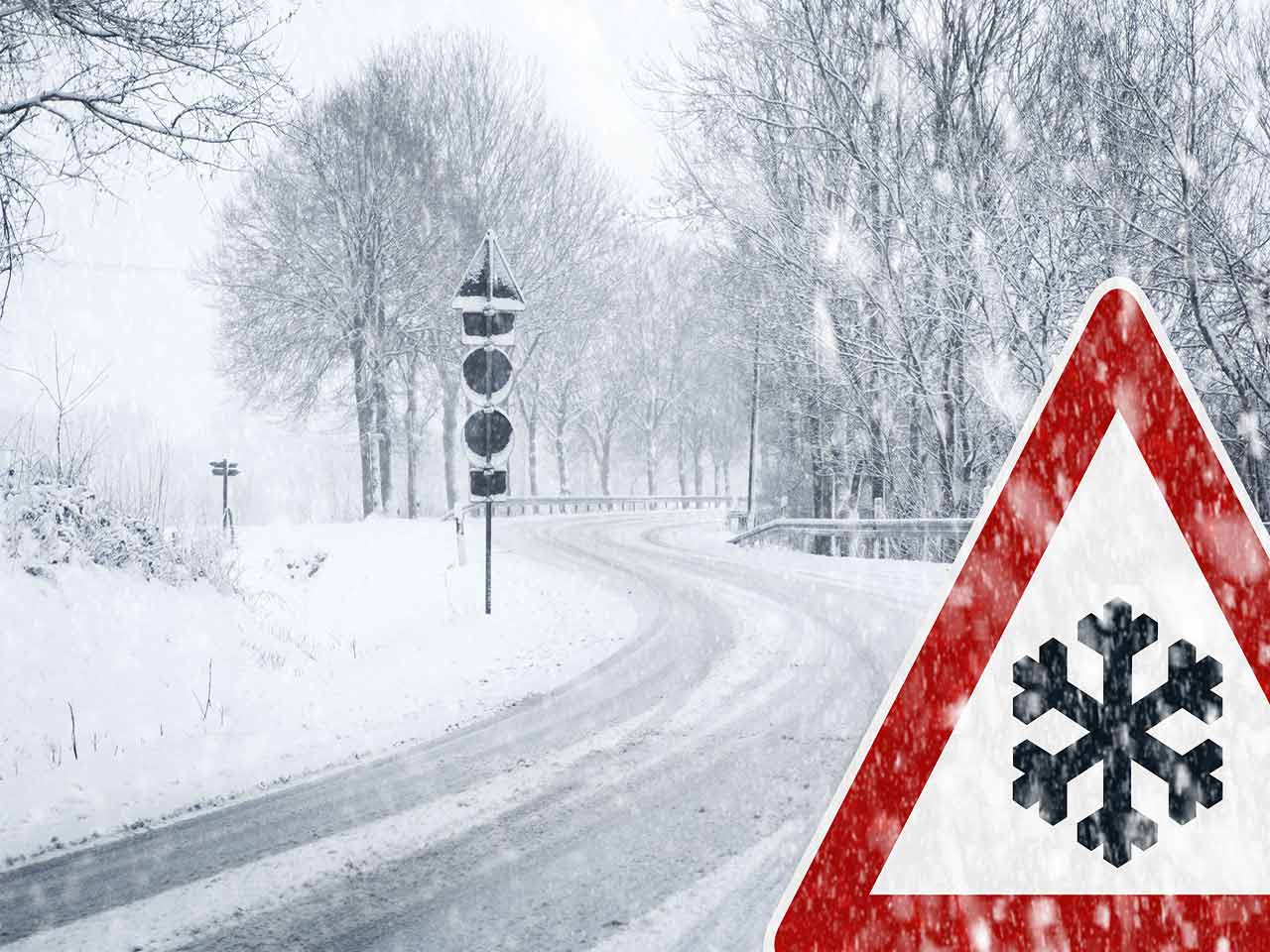
Carry an emergency kit Gather together the following items and pack in your vehicle at the start of the winter season. You never know when you might need them! Ice scraper and de-icer Torch and spare batteries - or a wind-up torch Warm clothes and blankets - for you and all passengers Boots First aid kit Jump leads A shovel Road atlas Sunglasses (the low winter sun and glare off snow can be dazzling) Before you set off – check the latest traffic and weather Have you planned your journey? In severe and wintry weather it's even more important to plan your journey. Highways England provides up to the minute traffic reports for its network of 4,300 miles of motorways and major A roads across England. Just a few minutes checking information services before you set off can make all the difference to your journey. Before you set off The Highways England website includes the latest traffic reports, maps showing how the traffic is flowing on England's motorways and major A roads, a motorway flow diagram, views from CCTV cameras, average speeds and the displays on motorway message signs. Road and weather conditions may change, drive with care When you're on the road, pay attention to the changing road, traffic and weather conditions. Be ready to slow down and take more care if you need to, particularly on bends and exposed roads. Don't be lulled into a false sense of security - even if you drive every day on the same stretch of road. Additional information and advice on driving in adverse weather conditions is available in the Highway Code or by visiting the Met Office advice pages. Updates on the move If you are away from your computer or have already set out on your journey, there are still lots of ways to get Highways England live traffic information. On overhead message signs – motorway control centres will flash up important travel messages, including warning you of delays and advising of alternative routes. There are also automatic signs telling you how long it will take traffic to reach certain destinations at that time. When you take a break On long journeys, consider taking a break at regular intervals - and that's an ideal time to check the traffic conditions on the road ahead. While you are safely parked, check the latest information via your mobile phone, iPhone or laptop. Never stop on the hard shoulder to do this and never use your mobile phone while driving. Driving through snow and ice Highways England looks after motorways and major A roads, and local authorities look after all the other roads. Both work as hard as they can to keep their networks clear during severe weather. Stick to the main roads where you can and avoid exposed routes. You should drive with care and respect the road conditions wherever you drive, but not every road can be treated. You need to take even more care driving on minor roads. Even if the time and location of snowfall is perfectly forecast, it will still take time to clear the snow after it has fallen. Remember though, snow ploughs can't get through if the road or motorway is full of stationary traffic. Give Highways England and local authority teams the space they need to do their job and help you on your journey! Steep hills and exposed roads are also likely to present more challenging driving conditions in snow and ice, so if you could avoid these it might make your journey easier. Make sure you can see and be seen. Clear snow and ice off all windows, lights and number plates. Leave extra space between you and other vehicles. Take even more care looking out for others that may not be able to stop and be extra cautious at road junctions where road markings may not be visible If you use a higher gear than normal it will help to avoid wheel spin on a slippery surface. Accelerate and brake gently to avoid skidding. Driving in rain and floods When the road is wet it can take twice as long to stop. Slow down and maintain a safe distance from the vehicle in front. If your vehicle loses grip, or “aquaplanes”, on surface water take your foot off the accelerator to slow down. Do not brake or steer suddenly because you have less control of the steering and brakes. When faced with a flooded road, be very careful as you can’t always tell how deep the water is. Just 30cm of flowing water can wash a car away. If you have no alternative but to drive through floods, drive slowly, use a low gear and try to keep the engine revving at a high rate. Move forward continuously to avoid stalling the engine. When driving an automatic vehicle, engage and hold in a low gear. And remember to test your brakes after driving through water; they may be ineffective. Driving in fog In reduced visibility, where you cannot see as much of the road ahead, you will need to slow down and drive more carefully. Use dipped headlights so that other drivers can see you. Fog lights and full beam can dazzle other drivers. Use fog lights when it’s really thick (less than 100m visibility) and then don’t forget to turn them off when conditions improve. Fog is often patchy so try not to speed up as soon as visibility improves. You could suddenly find yourself back in thick fog further up the road. Driving in windy weather Take extra care on the roads and plan your journey by checking the latest weather conditions. The traffic news, overhead motorway signs and Highways England digital information services will say if any roads or bridges are closed because of high winds. Though high-sided vehicles are particularly affected by windy weather, strong winds can also blow other vehicles off course. This can happen on open stretches of road exposed to strong crosswinds, or when passing bridges, high-sided vehicles or gaps in trees. Whatever the severe weather always adjust your driving according to the conditions. Make sure you can see clearly and that you can be seen. Use at least dipped headlights in poor visibility – and don’t just rely on daytime running lights if you have them. For more information check the Met Office advice pages. Check weather updates Take weather conditions into account when planning your route by visiting The Met Office website or listening to local radio broadcasts. Timing Always allow extra time in severe weather. Listen to warnings or advice and consider whether or not your journey is essential. If severe weather is forecast, can you plan your journey to travel before the worst of the weather? Or wait until it has passed? Or at least allow time after the snowfall for crews to do their work clearing the roads? It all helps. Remember, in severe weather you will need to allow more time for your journey. If severe weather is forecast are you able to change your travel plans? Can you work at home, for example? There can be lots of different pressures to make a journey – whether it’s the pressure to get to work, the pressure to make a delivery on time or the desire to see friends and family at Christmas. Remember none of these pressures are more important than your safety. When a prolonged period of severe weather is on the cards, we can all help to ease the pressures by allowing extra time for that delivery, being prepared to take a little longer for our journey and being flexible in our planning. Pre-journey checks: Are you safe to drive? Use this following handy reminder for pre-journey safety checks. It’s called the POWDERY checklist: P ETROL (or diesel). Have you got enough? Do you know where to fill up? O IL - check levels once a month W ATER - check radiator and screenwash once a month D AMAGE - check wipers, lights etc for signs of wear and tear or damage E LECTRICS - check lights, indicators and controls are working properly R UBBER - are your tyres well inflated, legal, with good tread and free from damage? Y OURSELF - are you fit to drive? Have you slept well? Are you taking any medication(s) that could make it unsafe for you to drive? If you are planning to travel with pets, ensure that animals are safe and secure, and will not be a distraction to people travelling in your vehicle - seek appropriate advice before you travel.
